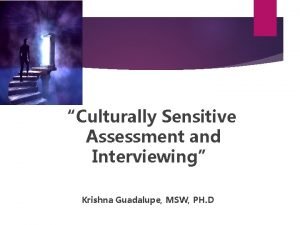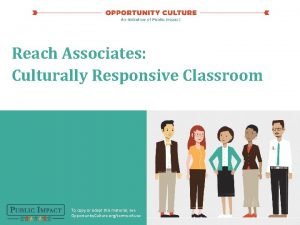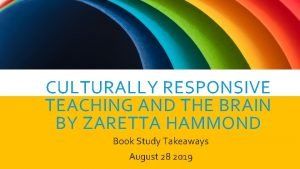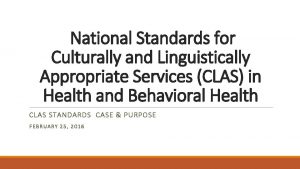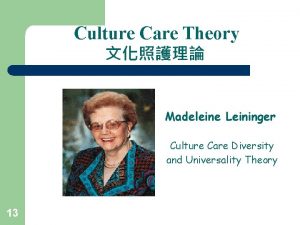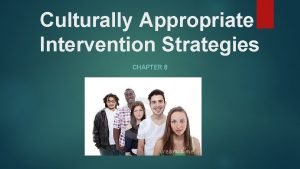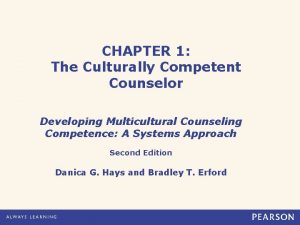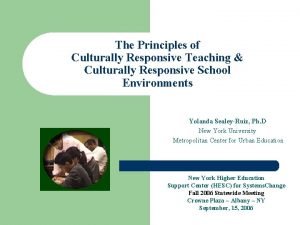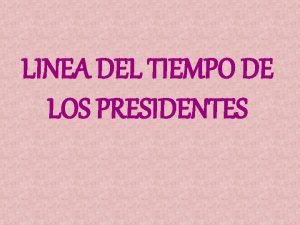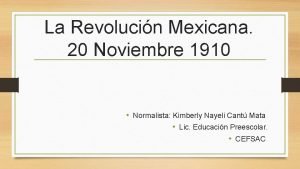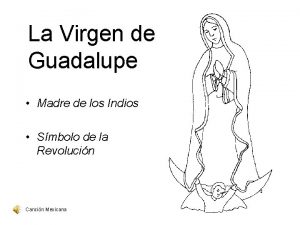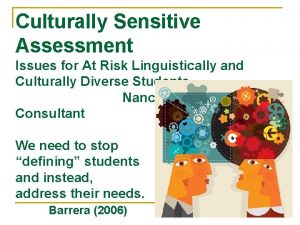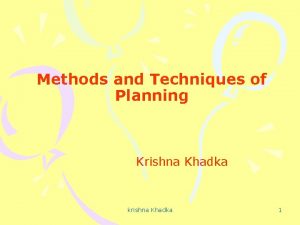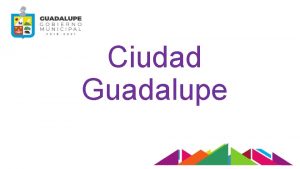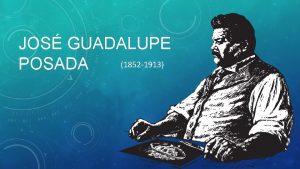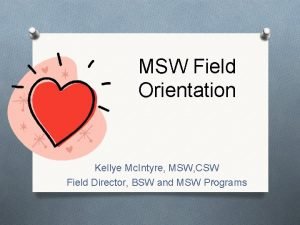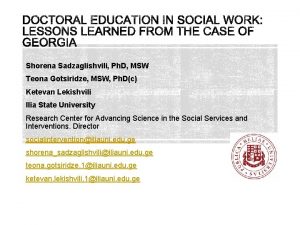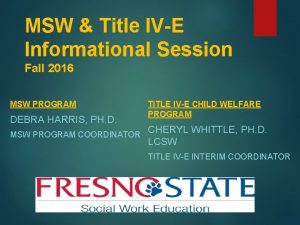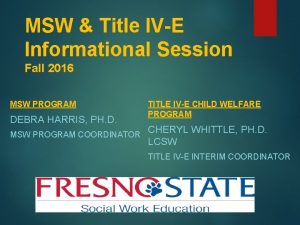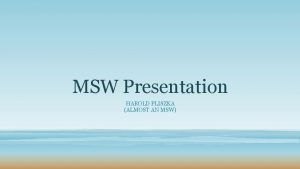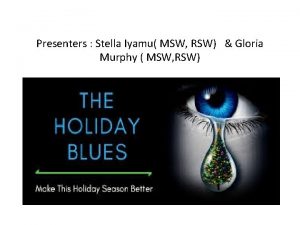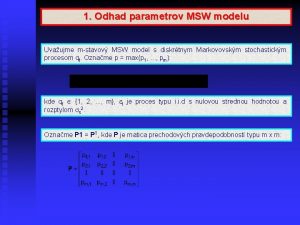Culturally Sensitive Assessment and Interviewing Krishna Guadalupe MSW






















- Slides: 22

“Culturally Sensitive Assessment and Interviewing” Krishna Guadalupe, MSW, PH. D

Culture A system of meaning comprised of beliefs, values, knowledge, and learned practices (i. e. , language and behaviors) transmitted from one group to another.

Culturally Sensitive Assessment and Interviewing What is it? How to practice it?

Culturally Sensitive Assessment and Interviewing An approach to prevent misunderstanding of information, based on interpretation of concepts / experiences, which otherwise can lead to misdiagnosing & mistreatment.

Cultural Sensitive vs. Notion of Cultural Competence Assumes no Preconceived notion understanding, of understanding regardless of pervious based on previous experiences. No comparison of Thus, a tendency for clients. comparison of The focus is on experiences. allowing clients to reveal their perceptions If one is not careful, the effects of implicit of truth / reality and biases increases from that space

Culturally Sensitive Assessment and Interviewing Major Practice Areas to be Considered: • Possible implicit biases and identification of strategies for addressing transferences • Honoring of cultural humility while engaging in client-centered approaches.

Case You received a referral from E Center, Migrant Seasonal/Migrant Early Head Start, regarding a 29 month old boy, Angel, who displays symptoms of Autism Spectrum Disorders (ASD). Some of the symptoms exhibited are: difficulty following simple commands; below ageappropriate expressive language skills; at times nonresponsive / seems to “tune others out; ” unusually long and severe temper tantrums; seems unable to engage in pretend play; etc. You schedule a home visit for an assessment. Once arriving at the house, you are met by Angel’s parents, Jesus and Carmen, and siblings, Giselle – 5 years old, and Julian – 8 years old. * What preconceived ideas may you already have after reading the referral?

Assessment: An Attempt at Understanding • Assessment: a process of gathering and analyzing information with the intention of attempting to gain a concise understanding of a client’s circumstances -strengths (i. e. , protective factors) and needs / challenges (i. e. , risk factors).

Practicing Being Present Ø What is being communicated? (i. e. , content) Ø How is it being communicated? (i. e. , emotion) Ø Who is communicating it? (i. e. , the observed or observer) Ø Purpose of the communication? (i. e. , intention, motive, etc. ) Ø Am I reacting or responding to the here and now?

Client-Centered – Culturally Sensitive Practice • Solicitation Questions • Clarification Questions • Self-Reflection Questions • Searching for Solution Questions © K. Guadalupe, Ph. D.

Framework For Understanding Practice Structure ü ü ü Context Theoretical Orientatio Purpose / Intention Knowledge Skills Etc Content Process © Krishna Guadalupe, Ph. D.

Possible Reasons For Resisting Services Ø Lack of Clarity/Confusion Ø Lack of Trust Ø Fear of the Unknown Ø Preconceived Ideas / Previous Experiences Ø Feelings toward Authority Figure Ø Client’s Feelings of Powerlessness Ø Transference and Countertransference

Culturally Sensitive - Intentional Practice Developing Concentration Ability to remain focused (breathing and active listening) Mindfulness and Breath Awareness of the breath (i. e. , lessening the power of mind’s conditions – we are more than the trauma that we have experienced) Ability to witness (i. e. , habitual thought patterns) without becoming distracted or confined The notion of culturally Ability to remain calm and intentional while experiencing what is sensitivity / humility, beyond cultural competence

Case You have been asked to assess a 34 month old child who displays symptoms of Attention Deficit Hyperactive Disorder (i. e. , inattention - trouble holding attention on tasks or play activities, often easily distracted, as well as hyperactivityimpulsivity - trouble waiting his/her turn, often unable to play or take part in leisure activities quietly, often leaves seat in situations when remaining seated is expected, exhibit restless behavior). You are not given any information about child / parents’ cultural – ethnic background or living circumstances. ü What information do you feel you need in order to better prepare for this assessment? ü If not able to find such information prior to the assessment, how would you go about approaching this case once

Dynamics of New Relationships * Effects of Previous Experiences & Cultural Differences * Ambivalent Feelings: Transference & Counter-Transference * Trust, Risk, & Confidentiality Issues * Resistance & Reluctance: Worker & Client * Preconceived Ideas: Worker & Client * Communication: Verbal & Nonverbal Messages * Sacred Moment: Here & Now Krishna Guadalupe, MSW, Ph. D. , Sac State

Motivational Interviewing http: //en. wikipedia. org/wiki/Motivational_interviewing Motivational Interviewing: goal-oriented; clientcentered approach eliciting behavioral change; exploration and resolution of ambivalence is a central purpose, and the practitioner is intentionally directive in pursuing this goal. It is non-judgmental, nonconfrontational and non-adversarial. Warmth, genuine empathy, and acceptance are necessary. Focus is on the present. Ultimately, practitioners must recognize that motivational interviewing involves collaboration not confrontation, evocation not education, autonomy rather than authority, and exploration instead of explanation. Four basic interaction skills 1. the ability to ask open ended questions,

Motivational Interviewing http: //en. wikipedia. org/wiki/Motivational_interviewing General Processes / Tasks: Engaging - involve the client in talking about issues, concerns and hopes, and to establish a trusting relationship with a practitioner. Focusing - narrow the conversation to habits or patterns that clients want to change. Evoking - elicit client motivation for change by increasing clients' sense of the importance of change, their confidence about change, and their readiness to change. Planning - develop the practical steps clients

Narrative Lens General Emphasis: * Focus on meaning attributed to challenges * Assessment addressed, yet, the primary focus is solution * Language must not be taken for granted (i. e. , the concept of “normal”& “functional”) General Goal: * Understanding the process of Construction, Deconstruction, and Reconstruction of narratives General Interventions: * Externalization of the problem (naming the problem) * Influence (effect) of the problem upon the person * Influence (effect) of the person upon the problem resist…? ) * Collapsing time & raising dilemma (evolution of problem) achieve this? ) * Enhancing change (i. e. , assisting with reconstruction) means to you? ) *Predicting setbacks * Use of Questions - Exceptional questions (i. e. , focus on situations of successful outcome - What are the times when you -History of exceptional questions (how did you -Significant question (What does this discovery

Some Interviewing Techniques * Clarification * Paraphrasing * Restatement * Interpretation * Summarization * Mirroring * Exploration * Partialization * Focusing * Use of silence (allowing time for ventilation) * Assurance - Reassurance * Encouragement / Reinforcement * Ventilation * Guidance

Self-regulation Theory(SRT) Self-Regulation: an active commitment to consciously manage one’s own thoughts, behaviors, and feelings / emotions. Why is it important? It allows us to practice consciously (manage impulses, addressing cognitive bias, etc)

Aspects How do I want to behave? What is the motivation for the desired behavior? Evaluation of behavior? What prevents me from engaging in the desired behavior? Internal strengths? • • • Observe / Identify Explore Options and Effe Development of plan Implementation / Practic Monitoring / Modify as N

See Me No, I am not the image printed in your mind, for the mind is limited by its own perceptions and conditions. No, I am not solely a reflection of a time in history, for change is constant, transformative, and ultimately time is an illusion. No, I am not exclusively a mirror of a culture, family system, a collective identity, for to see me like that is like seeing the forest while failing to remember the uniqueness and lifeness of each of the trees. No, I am not my name, profession, human roles, for those are boundaries through which we can begin communication. No, I am not my pains, sorrows, glories, healings, for these are only manifestations of my human experiences. I am the emptiness which is whole. I am the uncertainty which is certain. I am the spaceless which is filled with possibilities. Please, don’t diminish my existence. —Krishna L. Guadalupe
 Culturally responsive vs culturally relevant
Culturally responsive vs culturally relevant Motivational interviewing wiki
Motivational interviewing wiki Culturally responsive teaching self assessment
Culturally responsive teaching self assessment Culturally responsive teaching and the brain powerpoint
Culturally responsive teaching and the brain powerpoint Working with culturally and linguistically diverse families
Working with culturally and linguistically diverse families National culturally and linguistically appropriate services
National culturally and linguistically appropriate services Define cultural deprivation
Define cultural deprivation Vdoe culturally responsive teaching
Vdoe culturally responsive teaching Campinha-bacote
Campinha-bacote Madeleine leininger sunrise model
Madeleine leininger sunrise model Culturally responsive teaching in music education
Culturally responsive teaching in music education Classroom
Classroom Culturally appropriate intervention strategies
Culturally appropriate intervention strategies Culturally competent counselor
Culturally competent counselor Culturally relevant pedagogy
Culturally relevant pedagogy Tatiana and krista
Tatiana and krista No te vayas rianxeira letra
No te vayas rianxeira letra Adolfo ruiz cortines linea del tiempo
Adolfo ruiz cortines linea del tiempo Kimberly nayeli guadalupe
Kimberly nayeli guadalupe Madre de guadalupe
Madre de guadalupe Constelaciones en el manto de la virgen de guadalupe
Constelaciones en el manto de la virgen de guadalupe Manto de guadalupe
Manto de guadalupe Maforion
Maforion

